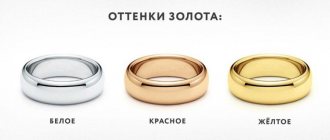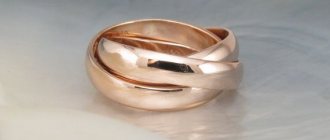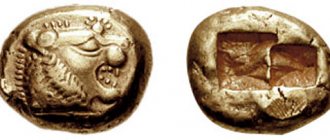Gold, in our understanding, is always associated with the color of the sun. It was for this color that it was considered equal to the daylight. The unique shine and inertness to many chemical reagents also served their purpose. All the more incredible is the mention of white, pink, green, purple and even black gold. People who are far from the jewelry business believe that all of the above are alternative precious metals. For example, white is platinum, and black is osmium. In fact, these are nothing more than misconceptions. 585 white gold contains the same number of carats of aurum as yellow gold of the same standard.
Historical reference
The opinion that white gold is a different metal did not arise out of nowhere. In the beginning, when platinum was not so well known and popular, it was actually called white gold. And they even replaced it with the real thing in jewelry and coins.
Platinum came to the Old World from America. The ancient civilizations of the Incas and Mayans have been processing the precious metal since time immemorial. Its refractoriness, inertness and high density were valued at the level of gold. However, these properties were not immediately noted. The metal was even disparagingly called “silver” (in Spanish, plata - silver) due to its color similarity to argentum.
The first deliveries of platinum were simply drowned in rivers and the ocean. The Spanish monarch issued a decree prohibiting its import into the territory of his country. Only 40 years later the new chemical substance was rehabilitated. The king's descendants began to counterfeit gold coins with his help. Platinum had a higher specific gravity than silver, and therefore the fact of falsification was not immediately discovered. The color of the new connection was revealed to the greedy rulers.
Even with 8–10% platinum alloy, the coins became white and resembled silver.
The second case in history when platinum was mistakenly called white gold happened during the development of the Ural mines. The new "Siberian metal", discovered in veins and impurities of gold ore, differed from previously known chemical elements. Having highly appreciated its properties, Russia began its production on an industrial scale. Within a couple of years, a method was invented to make platinum forgeable.
Popularity of white gold
The very first composition of white gold included platinum as a ligature. Such a connection was refractory, difficult to forge, and was not immediately noticed by jewelers. And even after the invention of new processing methods, products made from it came out massive and rough. The lack of filigree and high specific gravity were also the reasons for the lack of demand for jewelry made from this metal among buyers.
The situation began to change with the advent of elegant sets inlaid with stones. Many ordinary people have noticed that it is white gold that favorably sets off cold-glow minerals. Sapphires, rubies, and diamonds acquired additional aristocratic charm when framed in a new jewelry alloy. Even stones of medium hardness began to be perceived differently in rings and necklaces made of white metal. The minerals, transparent as a tear, showed their inimitable and unique charm in jewelry. This feature caused a lot of admiration and attracted many buyers. Sales growth was also stimulated by the increased price of platinum.
The peak of demand occurred in the 20–30s of the 20th century. The ladies flaunted their new jewelry with all their might. Showing up at a social event in sunny gold was considered bad manners. The cold stiffness, severity and versatility of white conquered continents and countries.
Fashion trends
The peak of popularity of the new alloy of the original shade occurred in the 20s of the last century. Consumers noted the harmonious combination of the new metal with precious stones. It hid the yellowness of not too pure diamonds, emphasized the coldness of sapphires, revealed the inner beauty of rubies and allowed us to look at emeralds in a new way. The neutral white color of the jewelry also looked good with a variety of outfits. Unlike silver, 585 white gold was not covered with a black patina and retained its charming shine even after prolonged wear.
But the new alloy had one significant drawback - its price. Jewelry made from it was more expensive than from ordinary gold. With the increase in the cost of platinum, chemists began to actively look for a worthy alternative. Silver was not even considered in this capacity, since in order to achieve a beautiful white color, it had to be added in excess quantities. Otherwise, the alloy was more like the color of light wood.
375 gold, which would really be white, contains so much argentum that it can be called silver.
After much experimentation, it turned out that adding platinum to Au compounds is not the only way to achieve beautiful coloring in jewelry. 14k white gold may contain other impurities. For example, nickel, manganese, and zinc have performed well in this regard. The use of these metals directly or as a secondary brightener in gold alloys has served as a new stage in the development of the jewelry industry.
Ligatures for white gold
As the cost of the new compound increased, the circle of people who could afford to buy such jewelry narrowed. This fact did not please the jewelers at all. In addition, platinum production in Russia, the largest exporter of this metal at the time, declined due to political turmoil. A kind of collapse was brewing. Consumers wanted elegant products in their private collections, and workshops could not satisfy their demand.
The easiest way to satisfy the need of its customers for original jewelry turned out to be to replace the ligature. Instead of platinum, jewelers began to select another metal that brightens the aurum. Attempts to dilute the alloy with silver were unsuccessful. For the compound to turn white, the percentage of argentum had to be greater than half. Otherwise, the products had a yellow-green or olive color. The value of such an alloy was small, since with constant wearing, rings and earrings quickly lost their attractiveness due to the appearance of a black patina.
The next metal destined to replace platinum was nickel. Au-Ni, Au-Ag-Ni, Au-Cu-Ni alloys turned out to be strong and hard. They were suitable for making not only decorative accessories, but could also serve purely practical purposes. Brooches, cufflinks, elegant pins, and filigree rings began to be made from the new compounds. Many fashionistas of that time adorned their fingers with exquisite white gold rings. But unfortunately, despite all the positive properties of the nickel ligature, its negative impact on humans was discovered.
Approximately 10–12% of the world's population suffers from allergies to compounds whose chemical composition includes this metal. Therefore, since 2000 in Europe, nickel has been officially banned from being used in the manufacture of jewelry and costume jewelry.
Zinc and manganese are secondary brighteners, so they are used in small proportions to the main Au-Cu or Au-Ag alloys. Considering the toxicity of these metals, jewelry made from them is not recommended to be worn constantly.
Care of coated products
Coated products require special care. You cannot wear galvanized jewelry to the bathhouse, pool, or swim in the sea. It is also necessary to protect the surface of coated parts from strong mechanical influences. With proper care, rhodium plating will last longer and preserve the appearance of jewelry.
Application of rhodium in the company “6MKM”
To perform high-quality rhodium plating, contact professionals. will do the job correctly, on time. In Moscow we have one of the lowest prices for this service, we are always responsible for our work. The technologist personally accepts the jewelry for work and warns in advance about all possible defects.
Gordienko Anastasia Vadimovna Author of the materials Position: chief technologist of 6 Micron LLC Education: higher Experience in galvanizing: 11 years
5 / 5 ( 165 votes)
Use of platinum metals
Having tried cheap analogues as alloys for white gold, chemists turned their attention to other representatives of the platinum group. Palladium became the ideal replacement. Its inertness, plasticity and high bleaching properties were positively noted by jewelers. So, to give a unique white color to the alloy, it is enough to add only 1% palladium to pure gold. In addition to the alloy of two metals Au-Pd, there are jewelry made from Au-Ag-Pd and Au-Pt-Pd compounds.
Ruthenium and rhodium also did not stand aside. Although they are not used as a ligature, they take part in the creation of white gold. Jewelry acquires a beautiful silver color by spraying. A thin layer of platinum metal is applied to the finished product using the galvanic method. During use, the jewelry wears out and after a while the base metal begins to show through the coating. In this case, it is recommended to renew the surface layer in a jewelry workshop.
The bright shine of rhodium-plated jewelry immediately attracts the attention of buyers. Sometimes unscrupulous jewelers take advantage of this by electroplating low-grade gold or silver items. To avoid such situations, when purchasing, you need to pay attention to the accompanying documents and tag:
- For gold items, the seal is made in the form of a spatula, and for silver items, it is in the shape of a barrel;
- Silver jewelry has a standard of at least 925, gold jewelry is marked with 585, 750 or 800 standard.
Even if the jewelry itself was made abroad, when undergoing certification in Russia, they are required to be sealed.
Officially recognized chemical compositions of white gold
The interstate standard, described in GOST 6835–2002, clearly defines the proportions of officially accepted compounds of gold with other metals. There are only 37 of them. The table below shows only white gold compositions:
| Try | Gold, % | Platinum, % | Palladium, % | Nickel, % | Impurities, no more than % |
| 950 | 94,5–95,5 | — | — | Ost | 0,11 |
| 930 | 92,6–93,4 | 6,6–7,4 | — | — | 0,11 |
| 900 | 89,6–90,4 | 9,6–10,4 | — | — | 0,11 |
| 840 | 83,5–84,5 | — | 15,5–16,5 | — | 0,13 |
| 800 | 79,5–80,5 | — | 19,5–20,5 | — | 0,13 |
| 600 | 59,5–60,5 | — | 39,5–40,5 | — | 0,13 |
| 600 | 59,4–60,6 | 9,5–10,5 | 29,5–30,5 | — | 0,18 |
This classification is followed by 10 countries of the post-Soviet space:
- Armenia
- Belarus
- Kazakhstan
- Kyrgyzstan
- Moldova
- Russia
- Tajikistan
- Turkmenistan
- Uzbekistan
- Ukraine
Chemical compositions of white gold not included in the standard
Our fellow citizens purchase some of their jewelry abroad. In other countries, they adhere to different proportions when creating jewelry. As a result, the noble metal does not lose its properties. But owners may have difficulty selling such jewelry or obtaining a loan for them at a pawnshop. Below are the most common chemical compositions of white gold.
| Try | Gold, % | Silver, % | Palladium, % | Copper, % | Nickel, % | Zinc, % |
| 583 | 58,3 | 23,7 | 18,0 | — | — | — |
| 583 | 58,3 | — | — | 23,5 | 12,2 | 6,0 |
| 750 | 75 | 5 | — | — | 20 | — |
| 585 | 58,5 | 25,5 | — | — | 16,5 | — |
| 750 | 75 | 5 | 20 | — | — | — |
Reviews
I managed to find inside information about white gold. Think before placing an order from an unfamiliar jeweler.
Buy factory-made products or from a famous foreign brand (Cartier jewelry house, for example). Then the decoration will not crumble or become covered with cracks.
Determination of metal sample
The owner of gold items made of yellow metal is accustomed to trusting his eyesight and often determines the sample “by eye”. White gold jewelry does not allow this to be done upon external inspection. In jewelry workshops and pawn shops, for such cases they use a special reagent - “chlorine gold”. A small drop on a fresh cut will tell an experienced appraiser the chemical composition of the alloy.
| Initial color of the product | Chlorine gold stain color | Tested metal |
| White | Dark green | High sterling silver |
| White | Yellow, gas is released, gradually turns black | Aluminum |
| White | Black | Tin |
| Grayish white | No changes | Platinum |
| Grey | Dirty yellow | Lead |
| White | Beige, gold or orange | White gold 583, 585, 750 |
| White | Brown | Gold below 500 standard |
| White | Dark brown or black | Fake |
conclusions
The design of earrings, bracelet, chain or pendant should correspond to the buyer’s image, mood and taste. Usually the shade is selected to match the tone of the hair and skin: on people with dark skin, precious objects made of white precious metal can look cheap and not prestigious. There are burning brunettes who do not like yellow earrings, bracelets, rings . Many people prefer chains and necklaces made of combined gold. At the same time, a precious thing of any shade requires special, regular care. Tips on how to clean gold jewelry in the video:










